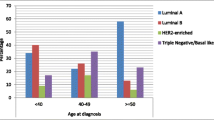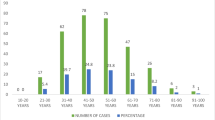Abstract
Objective Previous studies suggest that the majority of breast cancer in Africans are hormone receptor negative and thus differ from breast cancer in other populations. We decided to evaluate the hormone receptor status of patients seen in our practice to see if they indeed differ from that of other populations. Methods We prospectively collected and analyzed tumors from consecutive patients presenting to our clinic over an 18 months period from July 2004. During the period, we saw 192 patients without previous histological diagnosis and conducted routine histological and immunohistochemical analysis of their tumors for hormone receptor status. Results Most, 65.1% of tumors were ER+, 54.7% were PR+ and 79.7% were HER2 negative. Majority of the tumors, 77.6% were luminal type A, 2.6% were luminal type B, 15.8% were basal type and the remaining 4.0% (6/152) were HER2+/ER− subtype. We found an association between hormone receptor status and tumor grade but not with stage at presentation. Conclusion We conclude that there is no difference in the pattern of hormone receptors in breast cancer patients of African origin compared to other populations and urge more use of hormone manipulation for management of breast cancer in this population.
Similar content being viewed by others
References
Parkin DM, Ferlay J, Hamdi-Cherif M et al (2003) Cancer in Africa: epidemiology and prevention. IARC Press, Lyon
American Cancer Society (2007) Cancer facts & figures 2007. American Cancer Society, Atlanta
Ihekwaba FN (1992) Breast cancer in Nigerian women. Br J Surg 79:771–775
Adebamowo CA, Adekunle OO (1999) Case-controlled study of the epidemiological risk factors for breast cancer in Nigeria. Br J Surg 86:665–668
Anyanwu SN (2000) Breast cancer in eastern Nigeria: a ten year review. West Afr J Med 19:120–125
Hassan I, Onukak EE, Mabogunje OA (1992) Breast cancer in Zaria, Nigeria. J R Coll Surg Edinb 37:159–161
Otu AA, Ekanem IO, Khalil MI et al (1989) Characterization of breast cancer subgroups in an African population. Br J Surg 76:182–184
Chiedozi LC (1985) Breast cancer in Nigeria. Cancer 55:653–657
Elmore JG, Moceri VM, Carter D, Larson EB (1998) Breast carcinoma tumor characteristics in black and white women. Cancer 83:2509–2515
Middleton LP, Chen V, Perkins GH et al (2003) Histopathology of breast cancer among African-American women. Cancer 97:253–257
Mbonde MP, Amir H, Mbembati NA et al (1998) Characterisation of benign lesions and carcinomas of the female breast in a sub-Saharan African population. Pathol Res Pract 194:623–629
Jones BA, Kasi SV, Curnen MG et al (1997) Severe obesity as an explanatory factor for the black/white difference in stage at diagnosis of breast cancer. Am J Epidemiol 146:394–404
Miller BA, Hankey BF, Thomas TL (2002) Impact of sociodemographic factors, hormone receptor status, and tumor grade on ethnic differences in tumor stage and size for breast cancer in US women. Am J Epidemiol 155:534–545
Gukas ID, Jennings BA, Mandong BM et al (2005) Clinicopathological features and molecular markers of breast cancer in Jos, Nigeria. West Afr J Med 24:209–213
Ikpatt OF, Kuopio T, Ndoma-Egba R, Collan Y (2002) Breast cancer in Nigeria and Finland: epidemiological, clinical and histological comparison. Anticancer Res 22:3005–3012
Carey LA, Perou CM, Livasy CA et al (2006) Race, breast cancer subtypes and survival in the Carolina Breast Cancer Study. JAMA 295:2492–2502
Burstein HJ (2005) The distinctive nature of Her2 positive breast cancers. N Engl J Med 353:1652–1654
Murray E (2005) Breast cancer clinic at Groote Schuur Hospital. In: AORTIC Newsletter, Edition 2005, pp 10–11
Adebamowo CA, Ogundiran TO, Akang EE, Adams-Campbell LL (2003) ER/PR Status of Nigerian Breast Cancer Patients. In: American Association for Cancer Research Annual Meeting, Edition. AACR, Washington, DC, p 103301
Bertheau P, Cazala-Hatern D, Meignin V et al (1998) Variability of stored immunohistochemical reactivity on stored paraffin slides. J Clin Pathol 51:370–374
Olapade-Olaopa EO, Mackay HE (1998) Variability of immunohistochemical reactivity on stored paraffin slides. J Clin Pathol 51:943
Goldstein NS, Ferkowicz M, Odish E et al (2003) Minimum formalin fixation time for consistent estrogen receptor immunohistochemical staining of invasive breast carcinoma. Am J Clin Pathol 120:86–92
von Wasielewski R, Mengel M, Nolte M, Werner M (1998) Influence of fixation, antibody clones, and signal amplification on steroid receptor analysis. Breast J 4:22–40
Ogbimi RI, Adebamowo CA (2006) Questionnaire survey of working relationships between nurses and doctors in University Teaching Hospitals in Southern Nigeria. BMC Nursing 5:2
Cockburn R, Newton PN, Agyarko EK et al (2005) The global threat of counterfeit drugs: why industry and governments must communicate the dangers. PLoS Med 2:e100
Mann GB, Fahey VD, Feleppa F, Buchanan MR (2005) Reliance on hormone receptor assays of surgical specimens may compromise outcome in patients with breast cancer. J Clin Oncol 23:5148–5154
Nichols HB, Trentham-Dietz A, Love RR et al (2005) Difference in breast cancer risk factors by tumor marker subtypes among premenopausal Vietnamese and Chinese women. Cancer Epidemiol Biomarkers Prev 14:41–47
Schechter AL, Stern DF, Vaidyanathan L et al (1984) The neu oncogene: an erb-B-related gene encoding a 185,000-Mr tumour antigen. Nature 312:513–516
Slamon DJ, Clark GM, Wong SG et al (1987) Human breast cancer: correlation of relapse and survival with amplification of the HER-2/neu oncogene. Science 235:177–182
Clark GM, McGuire WL (1991) Follow-up study of HER-2/neu amplification in primary breast cancer. Cancer Res 51:944–948
Jones BA, Kasl SV, Howe CL et al (2004) African American/white differences in breast carcinoma: p53 alterations and other tumor characteristics. Cancer 101:1293–1301
Sørlie T, Perou CM, Tibshirani R et al (2001) Gene expression patterns of breast carcinomas distinguish tumor subclasses with clinical implications. Proc Natl Acad Sci USA 98:10869–10874
Author information
Authors and Affiliations
Corresponding author
Rights and permissions
About this article
Cite this article
Adebamowo, C.A., Famooto, A., Ogundiran, T.O. et al. Immunohistochemical and molecular subtypes of breast cancer in Nigeria. Breast Cancer Res Treat 110, 183–188 (2008). https://doi.org/10.1007/s10549-007-9694-5
Received:
Accepted:
Published:
Issue Date:
DOI: https://doi.org/10.1007/s10549-007-9694-5




